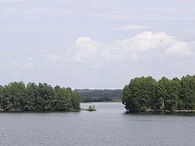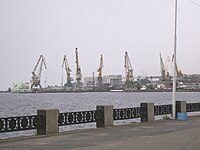Lake Onega
| Lake Onega | |
|---|---|
Kizhi Island) | |
| Settlements | Kondopoga, Medvezhyegorsk, Petrozavodsk, Pindushi, Povenets |
Lake Onega (/oʊˈnɛɡə/; also known as Onego; Оне́жское о́зеро, IPA: [ɐˈnʲɛʂskəɪ ˈozʲɪrə]; Finnish: Ääninen, Äänisjärvi; Livvi: Oniegujärvi; Veps: Änine, Änižjärv) is a lake in northwestern Russia, on the territory of the Republic of Karelia, Leningrad Oblast and Vologda Oblast. It belongs to the basin of the Baltic Sea, and is the second-largest lake in Europe after Lake Ladoga, slightly smaller than Lebanon. The lake is fed by about 50 rivers and is drained by the Svir.
There are about 1,650 islands on the lake. They include
Geological history
The lake is of glacial-tectonic origin and is a small remnant of a larger body of water which existed in this area during an Ice Age.[1] In geologic terms, the lake is rather young, formed – like almost all lakes in northern Europe – through the carving activity of the inland ice sheets in the latter part of the last ice age, about 12,000 years ago: In the Paleozoic Era (400–300 million years ago) the entire territory of the modern basin of the lake was covered with a shelf sea lying near the ancient, near-equatoric Baltic continent. Sediments at that time – sandstone, sand, clay and limestone – form a 200-metre-thick (660 ft) layer covering the Baltic Shield which consists of granite, gneiss and greenstone. The retreat of the Ice Age glaciers formed the Littorina Sea. Its level was first 7–9 m (23–30 ft) higher than at present, but it gradually lowered, thereby decreasing the sea area and forming several lakes in the Baltic region.[2][3]
Topography and hydrography
Lake Onega has a surface area of 9,891 km2 (3,819 sq mi) without islands and a volume of 291 km3 (70 cu mi); its length is about 245 km (152 mi) and width about 90 km (56 mi). It is the second largest lake in Europe, and the
 |
The numbers denote:
|
The average depth of the lake is 30 m (98 ft), and the deepest spot of 127 m (417 ft) is located in the northern part. The average depth is 50–60 m (160–200 ft) in the middle and rises to 20–30 m (66–98 ft) in the southern part. The bottom has a very uneven profile, it is covered with silt, and contains numerous trenches of various size and shape in the northern part. The trenches are separated by large shallow banks. Such bottom structure is favorable for fish, and the banks are used for commercial fishing.[6][7]
The water level is stabilized by the Verhnesvirskaya
The maximum surface water temperature is 20–24 °C (68–75 °F) on the open lake and 24–27 °C (75–81 °F) in the bays. The deep waters are much colder, from 2–2.5 °C (36–36 °F) in winter to 4–6 °C (39–43 °F) in summer.[8] Weather is relatively cold, with temperatures below 0 °C (32 °F) for half of the year and average summer temperatures of about 16 °C (61 °F).[9]
Basin and islands
The catchment area of 51,540 km2 (19,900 sq mi) drains into the lake via 58 rivers and more than 110 tributaries, including the Shuya, Suna, Vodla, Vytegra and Andoma. The only outgoing Svir, which marks the southern boundary of Karelia, runs from the southwestern shore of Lake Onega to Lake Ladoga and continues as the Neva to the Gulf of Finland.
The
There are about 1650 islands in the lake with a total area of about 250 km2 (97 sq mi).
 |
 |
 |
 |
| Cape Besov Nos with a lighthouse | Petrozavodsk Bay | Lakeshore | Islands |
Flora and fauna
The lake banks are low and are flooded with raising water level. They are therefore swampy and are rich in reed, hosting ducks, geese and swans. The coastal region is covered with dense virgin forests.
Lake Onega features a large variety of
Ecology
The lake area used to be clean but pollution is gradually increasing, especially in the northwestern and northern parts which contain the industrial facilities of Petrozavodsk, Kondopoga and Medvezhyegorsk. About 80% of the population and more than 90% of industry of the basin are concentrated in these areas. The pollution from these three cities amount to about 190 million cubic metres (6.7 billion cubic feet) of sewage and drainage water and 150 tonnes (170 short tons) of emissions per year. Human activity results in about 315 million cubic metres (11.1 billion cubic feet) of drain water per year, of which 46% are industrial and household water, 25% is
Economy
The lake basin is a major source of granite, marble and black schist in Russia which have been exploited in the area since the early 18th century.[9] Also advanced is metallurgy, especially in the Petrozavodsk area which produces about 25% of industrial products of Karelia.[15] Water level of the lake is controlled by the Nizhnesvirskaya (Нижнесвирская ГЭС, "Lower Svir") and Verkhnesvirskaya (Верхнесвирская ГЭС, "Upper Svir") hydroelectric power plants. The former was built between 1927 and 1938 and has a peak power of 99 MW. The construction of Verkhnesvirskaya plant started in 1938, but was interrupted by World War II and could only be resumed in 1947. The plant was completed in 1952 and provided 160 MW of electric power.[16] The associated with the plant Verkhnesvirsk Reservoir has an area of 9,930 km2 (3,830 sq mi) and volume of 260 km3 (62 cu mi), i.e. almost the same as those of Onega Lake. Its construction raised the water level of the lake by 0.5 m (20 in).[17]
The lake contains a well-developed navigation system which is part of the
Fishery is an important activity on the lake. About 17 species are being fished commercially, mostly
Whereas there is no regular passenger service on the lake, there are several tourist trips per day along the routes of Petrozavodsk–Kizhi, Petrozavodsk–Velikaya Guba and Petrozavodsk–Shala. They are run by hydrofoil and motor ships and are used for passenger transport as well.[19][20] In addition, passenger ships go on the route Petrozavodsk – Shala.[21]
Sailing is a popular activity on the lake and there is a sailing club in Petrozavodsk. Since 1972, every year at the end of July the lake has hosted the largest
 |
 |
 |
| Boats on the wharf "Kizhi" | The cargo port of Petrozavodsk | Petrozavodsk in 1915 |
History and places


Cities
The largest city on the lake is
Kondopoga has been known since 1495 and (before its destruction in 2018) contained the Uspenskaya (Assumption) Church from 1774. This 42-metre-tall (138 ft) edifice was the tallest wooden church of the Russian North. There are two carillons in the city, with 23 and 18 bells, also there is an indoor ice sports arena accommodating 1,850 spectators and a Palace of Arts with an organ.[25]
The town of Medvezhyegorsk was founded in 1916 and from 1931 became the construction base of the White Sea – Baltic Canal. Between 1703–1710 and 1766–1769 a factory was operating on the site of the city. During the World War II this area was occupied by the Finnish forces and was a place of busy military activities.[26]
Kizhi island
The main attraction of the lake is the island of Kizhi in the northern part of the lake, which is a State Historical, Architectural and Ethnographic Preservation Area. There are 89 wooden architectural monuments of the 15th to 20th centuries on the island. The most remarkable of those is
Onega petroglyphs
Another attraction of the lake are the Onega petroglyphs (rock engravings). They are located on the eastern coast of the lake and date back to between the 4th and 2nd millennia BC. There are about 1,200 petroglyphs scattered over the 20 km (12 mi) area including several capes, such as Besov Nos (see map above). The engravings are 1–2 mm (0.04–0.08 in) deep and depict animals, people, boats and geometrical shapes of circular and crescent shapes.[29]
In 2021, the petroglyphs were inscribed on the UNESCO World Heritage List for its significant artistic qualities that testify the creativity of the Stone Age.[30][31]
Others
Many other historical monuments are scattered around the lake. They include the Dormition Monastery (ru) on the cape Muromsky, on the eastern shore of the lake. The monastery was founded in 1350, closed in 1918 and revived in 1991.[32]
References
- ^ a b c d e f S.V. Kislovskiy Did you know? The gazetteer of the Leningrad region. LA: Lenizdat, 1974, pp. 104–105
- ^ A.V. Darinskii (1975). Leningrad Oblast. Lenizdat. pp. 14–26.
- ISBN 3-540-43201-9.
- ^ a b Encyclopedic Dictionary of Geography: Geographical names – Moscow: Soviet Encyclopedia. 1983, p. 319.
- ^ a b Lake Onega. russia.rin.ru. Retrieved on 2013-03-22.
- ^ a b Darinskii AV (1975). Leningrad Oblast. Lenizdat. pp. 43–45.
- ^ a b Karelia. Tourist portal Archived 2015-07-14 at the Wayback Machine. Ticrk.ru (2010-03-31). Retrieved on 2013-03-22.
- ^ a b c d e f Онежское озеро in the Great Soviet Encyclopedia, 1969–1978 (in Russian)
- ^ a b c d e f g Onega Lake (in Russian)
- ^ X-team. Lake Onega Archived 2012-03-08 at the Wayback Machine. X-team.ru. Retrieved on 2013-03-22.
- ISBN 978-0-12-369449-2.
- ^ Birds of Kizhi area (in Russian)
- ^ Fishes of Kizhi area (in Russian)
- ^ a b Anthropogenic influences on the ecosystem of Lake Onega. Novgen.freeservers.com. Retrieved 22 March 2013.
- ^ a b Петрозаводск in the Great Soviet Encyclopedia, 1969–1978 (in Russian)
- ^ "Verkhnesvirskaya GES". Great Soviet Encyclopedia.
- ^ "Verkhnesvirsk Reservoir". Great Soviet Encyclopedia.
- ^ Lake Onega (Karelia). Fishing in the Onega. Fish and their habitat Archived 2010-05-07 at the Wayback Machine. Vedlozero.ru. Retrieved on 2013-03-22.
- ^ Intercity (Water transport Petrozavodsk and Karelia) Archived 2018-07-27 at the Wayback Machine. Ptz-trans.ru. Retrieved on 2013-03-22.
- ^ Traffic Information on passenger vessels. Kizhi about. Valaam, Fr. Solovki Archived 2010-04-10 at the Wayback Machine. Ticrk.ru. Retrieved on 2013-03-22.
- ^ Vesti Karelia. Comets go to Shalu Archived 2011-07-20 at the Wayback Machine. Vesti.karelia.ru. Retrieved on 2013-03-22.
- ^ (in Russian) The Onego Regatta. Gov.karelia.ru. Retrieved on 2013-03-22.
- ISBN 0-7864-2248-3.
- ^ Administration of Petrozavodsk. Official website Archived 2011-07-26 at the Wayback Machine (in Russian)
- ^ Pearl of Karelia – Kondopoga. Kondopoga.ru. Retrieved on 2013-03-22.
- ^ "History of Medvezhyegorsk". Archived from the original on June 24, 2009. Retrieved 2010-06-16.
{{cite web}}: CS1 maint: bot: original URL status unknown (link). karelia.pp.ru (in Russian) - ^ "The State Historical-Architectural and Ethnographical Museum-Reserve "Kizhi"" (Official Site, in Russian). Retrieved 4 February 2010.
- ^ Kizhi Pogost. UNESCO.org. Accessed 16 June 2023.
- ^ "Petroglyphs on the eastern shore of Lake Onego". Official Karelia – Official Site of the public authorities of the Republic of Karelia. Retrieved 2010-02-04.
- ^ "Petroglyphs of Lake Onega and the White Sea". UNESCO World Heritage Centre. United Nations Educational, Scientific, and Cultural Organization. Retrieved July 28, 2021.
- ^ "World Heritage Committee inscribes four cultural and one natural site on UNESCO's World Heritage List". UNESCO World Heritage Centre. United Nations Educational, Scientific, and Cultural Organization. Retrieved July 28, 2021.
- ^ Sights and monuments, Official Web portal of Karelia Government
External links
- Kropotkin, Peter Alexeivitch; Bealby, John Thomas (1911). . Encyclopædia Britannica. Vol. 20 (11th ed.). p. 105.
